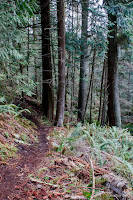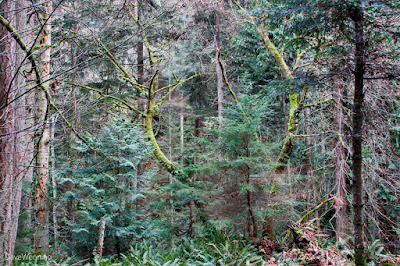Big Cedar Trail, Deception Pass State Park
There is a brand new trail in Deception Pass State Park called the Big Cedar Trail. The photo shows just the base of its namesake, a Western Redcedar, Thuja plicata. I find it is difficult to portray the size of a big tree in photos. Without a person standing next to it for reference, it could be run-of-the-mill. Let me say, if a six foot man was added to the photo, he would easily fit in the frame. The tree is 8 feet (2.4 m) in diameter and 26 feet (8 m) in circumference at shoulder height. It is truly a very big tree.
This past summer, I recall seeing a line of ribbons tied to shrubs heading off the left side of the Ginnett trail. I wondered if something like this was planned. We can thank the volunteers of SWITMO (Skagit-Whatcom-Island Trail Maintaining Organization) for clearing and cutting the new trail. Anyone hiking it will appreciate the labor that was required.
The new trail, shown in red, is in the Pass Lake section of the park. It connects the Ginnett Hill trail (no. 6) with the Pass Lake Loop trail (no. 5). Hikers exploring Ginnett Hill now have an alternate return route to the Pass Lake Loop. This avoids having to return using the same trail.
If taking the north to south route on the Big Cedar, be prepared for a steep climb. This can be avoided by going in the opposite direction. In my case, I find it easier to keep my feet under me hiking uphill rather than on steep downhills. My route was the east Pass Lake Loop-Ginnett Hill-Big Cedar-west Pass Lake Loop for a leisurely two hours. After doing this, I am glad I made this choice. You can visit the tree and avoid both the climb and the steepest descent. Enter the Big Cedar Trail from the top of the Pass Lake Loop. The tree is not far from there.
The Ginnett Hill trail is one of my favorite places in the park. It starts in a dry coniferous forest, descends into a small rain forest in Naked Man Valley (a.k.a. Heilman Valley), then climbs back into dry coniferous at the summit homestead site. The terrain is incredibly varied with a lot of nature to explore. This is not a heavily visited section of the park. Many people are missing out on some of the park's real treasures. Click or right-click the photos to view them full size.
Clockwise from upper left: 1. Several notched stumps serve as historic sites commemorating the region's logging heritage. They could be 100 years old or more. 2. Giant glacial erratics provide homes for moss and Licorice Ferns. Do these stones reveal how the valley was formed? 3. The three gargoyles conceal a hidden pond that fills with bright yellow Skunk Cabbage in the spring. 4. Rain forest denizens greet you at trailside.
As you begin climbing out of the valley, look for the junction to the Big Cedar Trail. There's no sign yet, but go left to Big Cedar, right to continue up Ginnett Hill.
Almost immediately on entering the Big Cedar Trail, a long, steep climb begins. A few short switchbacks help, but not much. Because the trail is new, the surface is still loose and rocky in places. Wear sturdy hiking boots with good traction. You'll also want them waterproof. In winter, there are seasonal wadis to cross on the Ginnett Hill trail and some muddy spots on the Big Cedar. Part of the west Pass Lake Loop is an old logging road. Much of it goes under water in the winter.
The trail levels off a bit near the top where you will find yourself in a ravine. Look for the bones of another big redcedar that didn't survive our windstorms or perhaps fire (right photo).
Soon, you will spot the Western Redcedar that gives the trail its name. Just as our Douglas Fir is not a fir, this is not a true cedar. It is actually an arborvitae ("tree of life") in the Cypress family. True cedars are in the Pine family. It has probably been dubbed "cedar" because of the wonderful color, fragrance and durability of its wood.
Pojar and Mackinnon describe the redcedar as the cornerstone of Northwest Coast native culture:
"A Coast Salish myth says the Great Spirit created redcedar in honour of a man who was always helping others. Where he dies and where he is buried, a cedar tree will grow and be useful to the people--the roots for baskets, the bark for clothing, the wood for shelter."The Quinalt call themselves the "Canoe People, the People of the Cedar Tree." It is called the "tree of life" by the Kwakwaka'wakw. When you visit the tree at Deception Pass, be mindful how important these wonderful redcedars have been in our local history.
Continuing on the Big Cedar Trail, I spotted a Star Gate disguised as a pair of Big-leaved Maples.
One of the highlights of the west Pass Lake Loop is a large moss meadow surrounding the trail. The meadow includes shrubs decorated with blue-green lichens. Mosses are at their best after the rains start in the fall and in winter.
Pileated Woodpeckers have been working diligently on this old Douglas Fir snag. The decaying wood hosts a lot of goodies to eat. Perhaps in time, this will become a Chickadee condominium. Nothing goes to waste in a forest.
Directions: From Interstate 5, take the Highway 20/Anacortes Exit 230 at Burlington. Head west and cross the bridges onto Fidalgo Island. Watch for the Deception Pass/Port Townsend Ferry intersection and go left (in a couple of years, this will be a traffic circle). You will come to Pass Lake bordering the highway. The parking lot is just off the highway on Rosario Road. Bring your Discover Pass or purchase a day pass at the parking lot.

















